13.3 Layers of Time: Sedimentary Rocks
Explain the three types of sedimentary rocks, where they form, and how they provide information about Earth’s history.
The desert in today’s southwestern United States was once a large, shallow sea and series of large freshwater lakes that dried up and re-
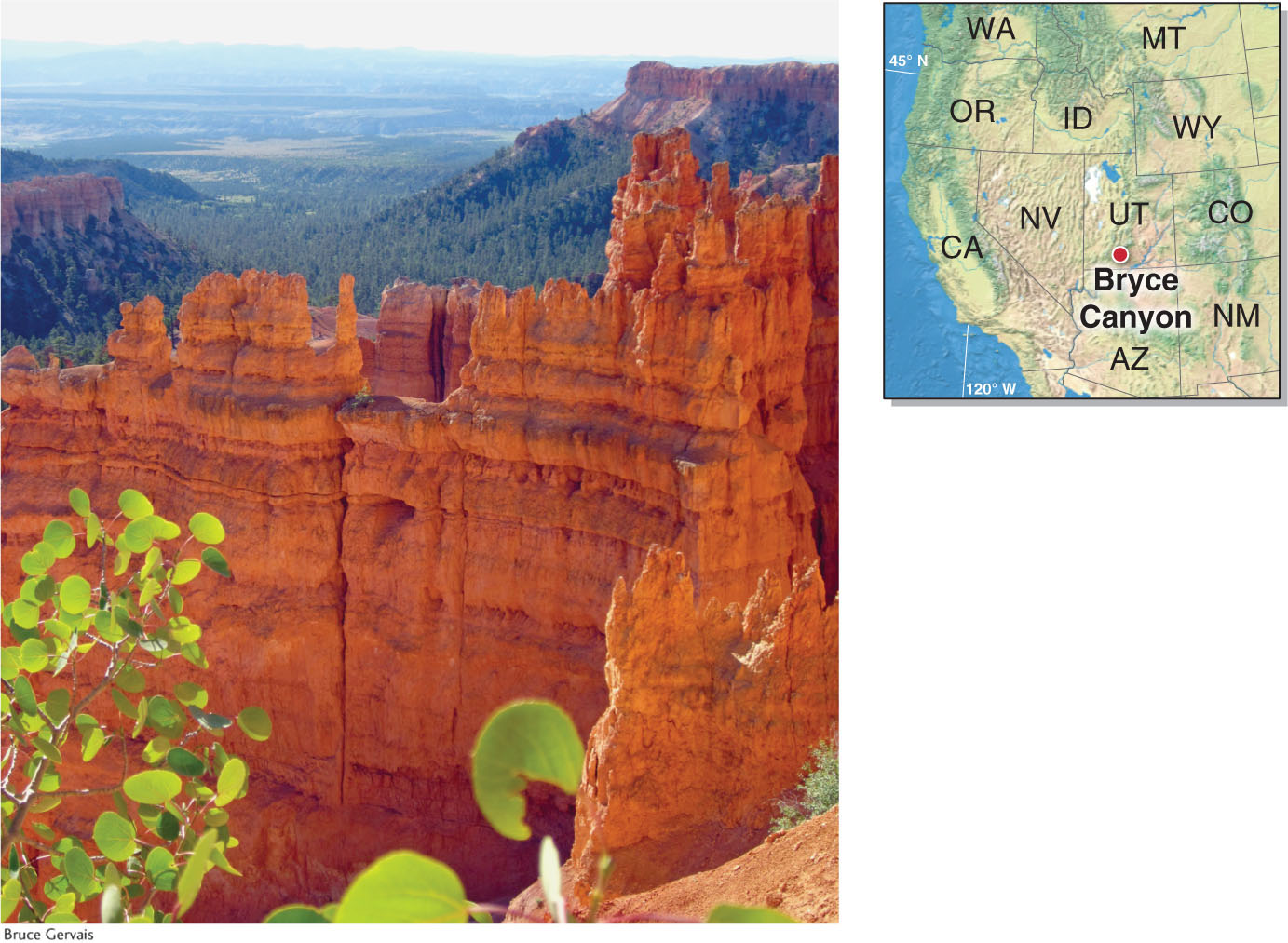
Figure 13.11
426
Sedimentary Rock Categories
There are three types of sedimentary rock: clastic sedimentary rock, organic sedimentary rock, and chemical sedimentary rock. These three types are distinguished by the kinds of sediments of which they are composed, the environment in which they form, and the processes that form them (Table 13.1). Clastic sedimentary rock is composed of broken pieces of other rocks; the sizes of those pieces determine the kind of clastic sedimentary rock that forms (see Figure 9.4). Organic sedimentary rock is composed mostly of organic material derived from ancient organisms or their shells. Chemical sedimentary rock is formed as dissolved minerals are precipitated out and as water evaporates.
|
1. Clastic sedimentary rocks Composed of rock and mineral fragments |
|
|
ROCK TYPE |
FORMED FROM |
|
Claystone |
Clay |
|
Shale |
Clay |
|
Siltstone |
Silt |
|
Mudstone |
Silt and clay |
|
Sandstone |
Sand |
|
Conglomerate |
Cobbles, sand, silt, and clay |
|
2. Organic sedimentary rocks Composed of the remains of organisms |
|
|
ROCK TYPE |
FORMED FROM |
|
Fossiliferous limestone |
Shell fragments from coral reefs |
|
Chalk |
Shell fragments of marine phytoplankton |
|
Bituminous coal |
Peat |
|
3. Chemical sedimentary rocks Composed of precipitated and evaporated mineral deposits |
|
|
ROCK TYPE |
FORMED FROM |
|
Rock salt (halite) |
Evaporated water |
|
Gypsum |
Evaporated seawater |
|
Limestone and tufa |
Precipitated calcium carbonate |
clastic sedimentary rock
Sedimentary rock composed of broken pieces of other rocks.
organic sedimentary rock
Sedimentary rock composed mostly of organic material and derived from ancient organisms.
chemical sedimentary rock
Sedimentary rock that forms as dissolved minerals are precipitated out of water.
Sedimentary rocks form only in depositional environments, which are places where sediments accumulate. The sedimentary rock formations we see in today’s landscapes reflect the environments in which their sediments accumulated and lithified long ago. There are many depositional environments on Earth’s surface. Figure 13.12 shows some of the more geographically widespread environments in which sediments accumulate.
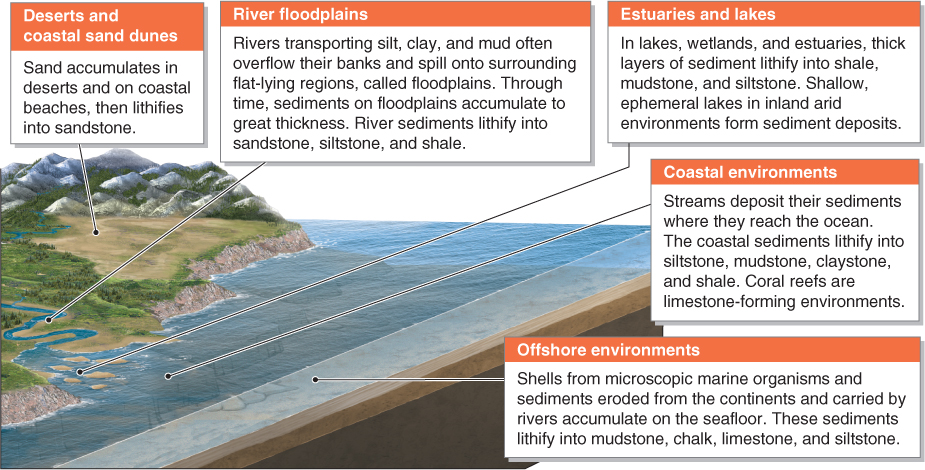
Figure 13.12
The processes that form sedimentary rocks operate under the principle of uniformitarianism (see Section 11.2). These slow and gradual processes are difficult to observe on human time scales, but nonetheless operate in the world around us today. Crunch the Numbers asks you to calculate how long it takes for sediments on the seafloor to develop into sedimentary rock.
427
CRUNCH THE NUMBERS: Offshore Sediment Accumulation Times
CRUNCH THE NUMBERS: Offshore Sediment Accumulation Times
Sediment depth and rates of sedimentation on the ocean floor vary greatly. Many seafloor regions are covered with 1 km of sediment or more. Accumulation rates of 2 cm of sediment per 1,000 years (or 0.002 cm per year) are common. At that rate, how long does it take for 1 km of sediment to accumulate?
Question 13.3
L7qUcwcbu5b9IKtmLJG/LZa8egYwuhKljM3CByzzlG9Oo6fCKD0e73fov147fLfvlx6gnpH+bEgzUQXOlCOBmG9pIuE1Q1kR14z7MXbBQyL6+vwB9pyMxZqf6pO2LTHyUsk+7UQEomtLsLv9EsqEZV2fgatTChrNQuestion 13.4
Ir93HVbebAV+3Wo8nrmCgKQ6Ie9O06p02LC635uddWmlbZebLv/T3+1SoKqXqqQqGUwezc14zKwwWU+mU9elKWuFO//cQDLxGSlXyQdMCQ8=
The Three Most Common Sedimentary Rocks
Although 96% of Earth’s crust is composed of igneous and metamorphic rocks, most of the rocks exposed on the crust’s surface are sedimentary rocks (Table 13.2). About 99% of those sedimentary rocks are shale, sandstone, or limestone. Shale is a clastic sedimentary rock formed from clay-
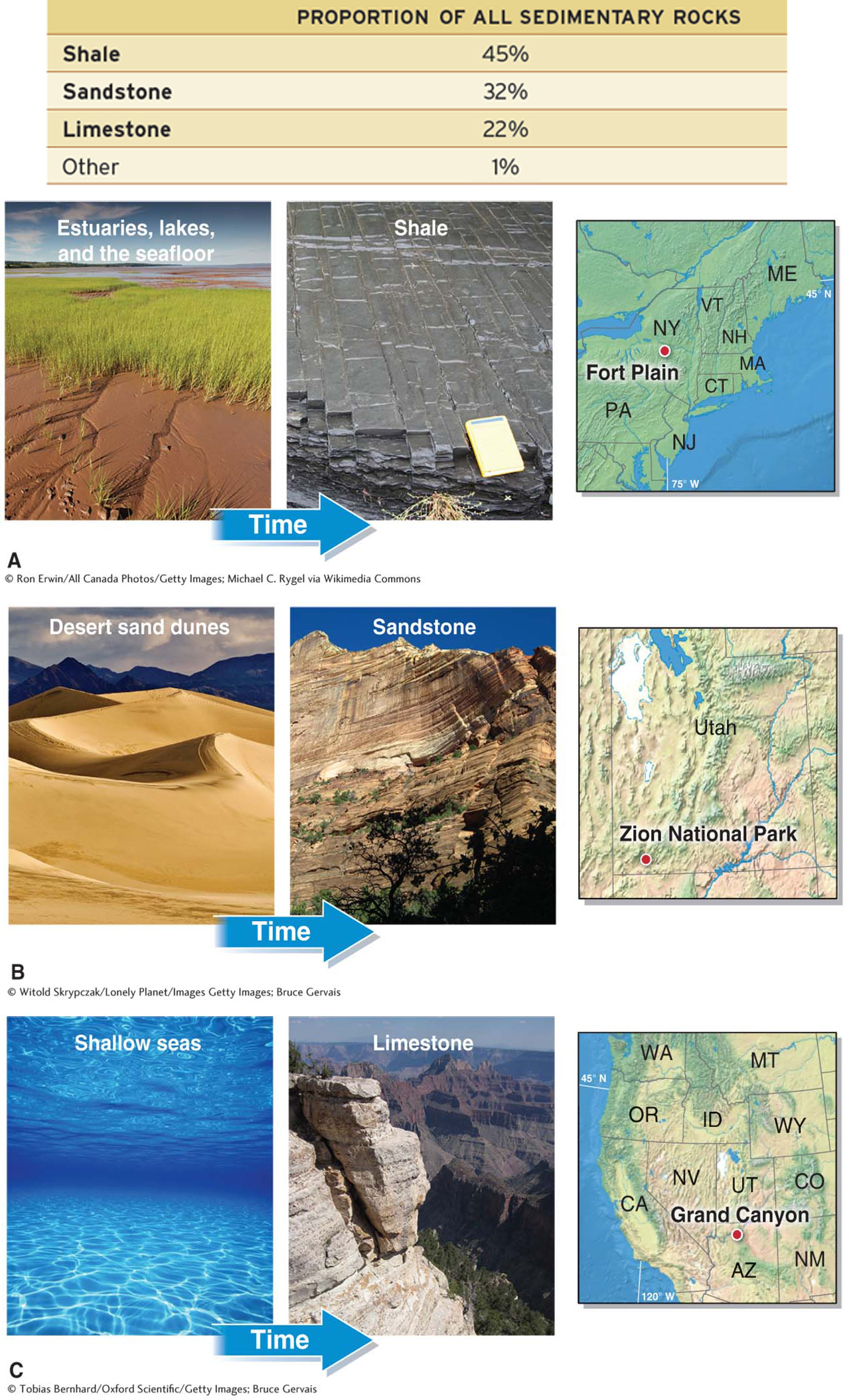
Figure 13.13
|
|
PROPORTION OF THE CRUST |
PROPORTION EXPOSED AT THE SURFACE |
|---|---|---|
|
Igneous and metamorphic rocks |
96% |
25% |
|
Sedimentary rocks |
4% |
75% |
shale
A clastic sedimentary rock formed from clay.
sandstone
A clastic sedimentary rock composed chiefly of quartz sand grains.
limestone
A chemical sedimentary rock composed mostly of calcite.
428
Economically Significant Sedimentary Rocks
Human society is built on natural resources. Most natural resources must either be mined or grown. In the case of minerals and rocks, they must be mined. Among the sedimentary rocks, coal, shale, and some chemical sedimentary rocks are particularly important in this regard.
Buried Sunshine: Coal
The most economically valuable sedimentary rock is coal. Coal is an organic rock that is formed from the remains of terrestrial wetland forests. The two main types of coal are bituminous coal and anthracite coal. Bituminous coal is an organic sedimentary rock formed from peat, and anthracite coal is a metamorphic rock that forms as bituminous coal is subjected to great heat and pressure.
coal
An organic rock formed from the remains of terrestrial wetland forests and widely used today as a fuel source.
Question 13.5
What is coal?
Coal is a rock formed from the remains of terrestrial forests that grew 300 million years ago or more.
Coal forms from ancient deposits of peat, a brownish-
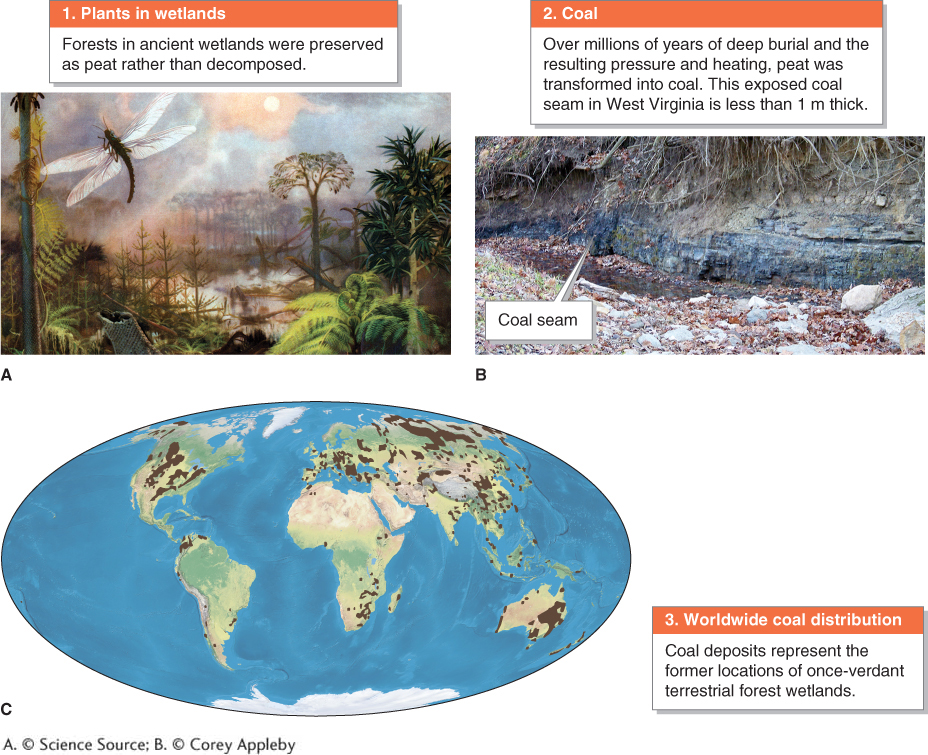
Figure 13.14
peat
A brownish-
Coal plays a central role in today’s world economies, and about 36% of the energy consumed in the United States comes from coal. Unfortunately, many types of coal mining are environmentally destructive, particularly the widespread practice of coal mountaintop removal in West Virginia, described in Picture This.
Petroleum
Petroleum (or oil) is not a mineral or rock because it is a liquid. It deserves special mention here, however, because it is found in association with sedimentary rocks. In addition, it is an economically vital material resource for humanity today.
Petroleum is a hydrocarbon, meaning that it is composed of chains or rings of molecules made of hydrogen and carbon atoms. Like coal, it is derived from the organic remains of ancient organisms. Whereas coal is formed from ancient terrestrial wetland forests, petroleum is formed from the remains of ancient marine zooplankton and phytoplankton.
429
Picture This
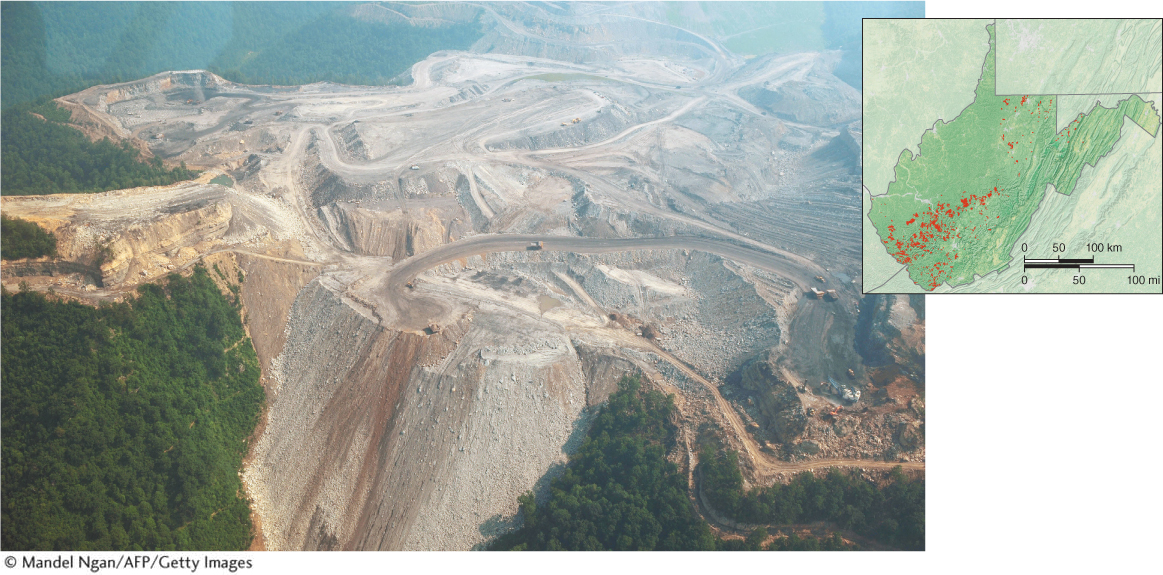
Coal Mining by Mountaintop Removal
Coal is a relatively inexpensive energy source because it is easily mined and there are abundant supplies of it worldwide. Coal produces abundant energy. But mining (and burning) coal takes a toll on the environment.
In the United States, coal is readily accessible near the crust’s surface throughout much of the Appalachian Mountains, particularly in West Virginia. Mountaintop removal is a technique of coal mining used when coal deposits are too close to the surface to be safely mined underground. Surface vegetation, soil, and rock are removed to extract the coal deposits beneath. In all, about 470 mountaintops have been leveled in Kentucky, West Virginia (shown in photo and inset map), Virginia, and Tennessee since the 1980s, and 4.9 million hectares (12 million acres) of temperate deciduous forest have been destroyed by coal mountaintop removal.
Mountaintop removal also causes significant water pollution. The removed soil and rock, or overburden, is deposited in adjacent valleys. More than 1,100 km (700 mi) of streams in the Appalachian Mountains now lie beneath overburden. The overburden leaches toxic trace elements such as selenium, lead, nickel, and cadmium. These elements enter stream systems, where they poison the organisms that live in the streams and the people who drink water from them. After the coal has been removed from the mining area, the mining companies are required to replant vegetation (a practice called reclamation), but the streams and their biodiversity are lost.
Consider This
Question 13.6
RoPPGyzqOWZCqymO/RjC6Ig+EtIRjX8MmW6gzvOwu9cxTaEwdVWsEXS2CkBT5iHrjyiZq0nnkq5ckEhpdWeXUdRJgOd0gfRc9wQ8rzxXxR4TJjrpfsUN9TH7wGFKD4vM9lOkgQVjX1/j/u0wwZWxDMR7mdxGH7vXYFQxb5kCCQbm70Ed/5ujjS43RtbHakrE/AokeYnUjfk3r/Z1i/I8iKPYIbCanfH7ysLKBg==Question 13.7
BiRZCmnJ8e36aVLplSihwjUx5LSyCOE5JrkECVpzXYlFTcox/qNhVrqTE68jN8SHIP6FOWQfCelKF5wwFeQ5kzK2BnHjIlyEGvhdUU4G0BQuNx7lRQLxk3eJLK6ldwJsyGj4OOFP5Gq1cGdTaIyBLv6/xAdRDrmr568p5E4V/aIocJ+Wee85CIo7Y030frMiZ9WVNZcZew3tfucG5lxGyvFt1J8dv2qS
As much as modern society depends on coal, petroleum is equally or even more important to our everyday lives, accounting for about 25% of the U.S. energy supply. On average, each person in the United States uses about 70 L (20 gal) of petroleum each day.
Sedimentary rocks are often associated with deposits of petroleum and natural methane gas. Shale can form a porous reservoir, where natural gas and petroleum accumulate. On the other hand, if shale is nonporous, it can form a cap rock, trapping petroleum and natural gas beneath the ground.
430
 Some porous shale can hold natural gas within its pore spaces. Such “shale gas” is playing an increasingly prominent role in the North American energy supply. Shale gas currently provides about 35% of the natural gas supplies in the United States, and this figure is growing rapidly due to the current boom in shale gas extraction. This controversial topic is explored in the Geographic Perspectives at the end of this chapter.
Some porous shale can hold natural gas within its pore spaces. Such “shale gas” is playing an increasingly prominent role in the North American energy supply. Shale gas currently provides about 35% of the natural gas supplies in the United States, and this figure is growing rapidly due to the current boom in shale gas extraction. This controversial topic is explored in the Geographic Perspectives at the end of this chapter.
Evaporites
Some chemical sedimentary rocks have significant economic value. One such group of chemical sedimentary rocks is the evaporites, which are used in many applications, ranging from lithium ion batteries (lithium) to construction materials (gypsum) to seasonings (table salt). An evaporite is a deposit of one or more minerals resulting from the repeated evaporation of water from a basin. Figure 13.15 highlights one particularly important evaporite deposit, Salar de Uyuni in Bolivia.
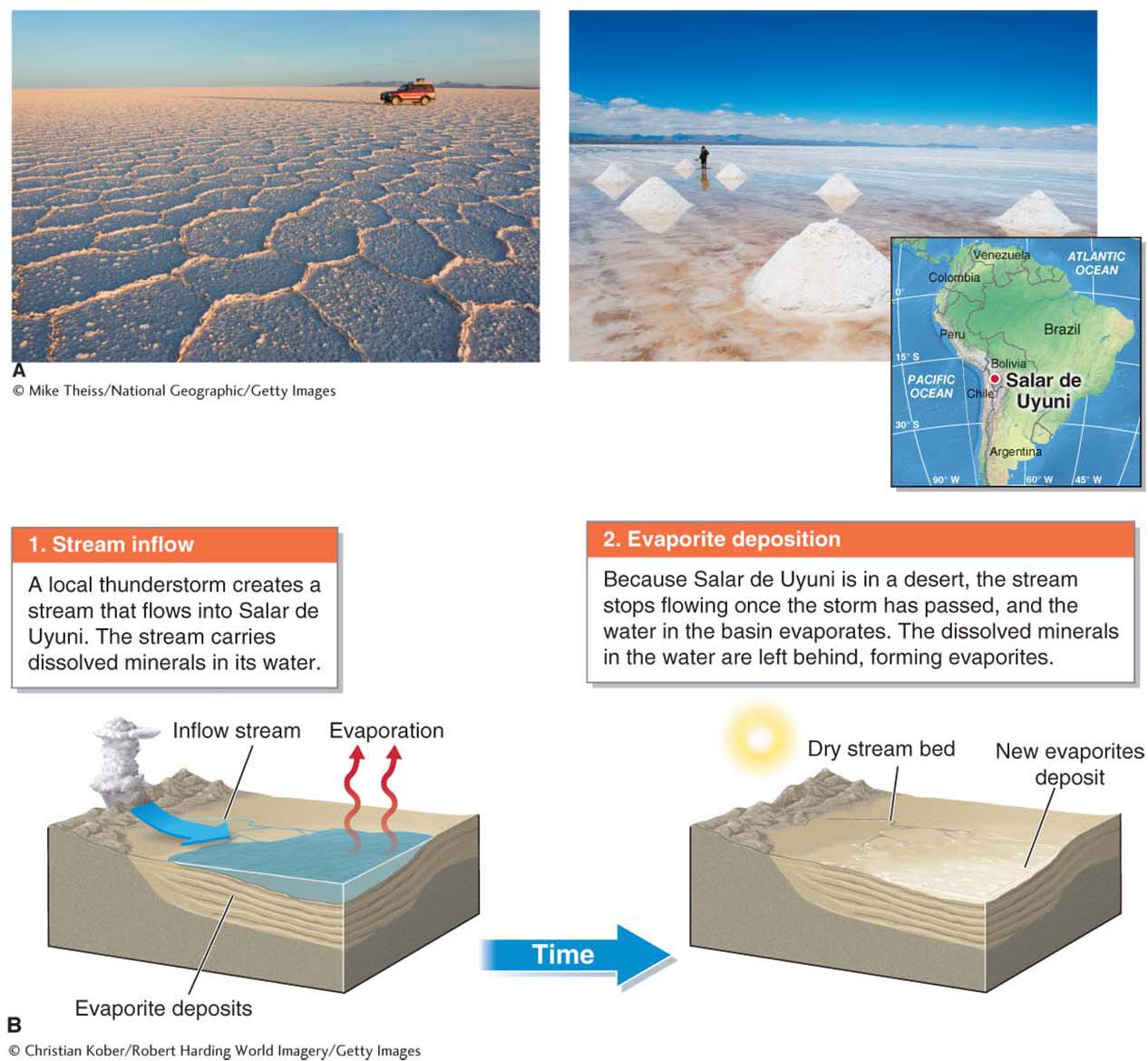
Figure 13.15
evaporite
A deposit of one or more minerals resulting from the repeated evaporation of water from a basin.
431
Windows to the Past: Fossils
Sedimentary rocks reveal much about Earth’s ancient life and environments because it is in these rocks that fossils are preserved. Fossils are the remains or the impressions of organisms preserved in sedimentary rock. Figure 13.16 explores the use of fossils to study Earth’s ancient history.

Figure 13.16
fossil
The remains or the impression of an organism preserved in sedimentary rock.
432